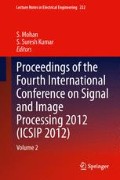Abstract
In this work, ear biometrics has been used for gender classification. Identifying a person as male or female is an interesting problem and is required in many practical applications. The earhole has been considered as the primary reference point. Relative distances (Euclidean distance) have been measured between the ear identification points (ear features) and the ear hole. The ear features considered are outer lobe edge, outer and inner curves of the helix, outer and inner curves of the antihelix and two edges of the concha. We have used an extensive internal database of about 342 samples of male and female ears. The Bayes classifier, K-Nearest Neighbour (KNN) classifier and the neural network classifier have been used for the classification. Overall classification rate of 90.42 % is achieved using KNN classifier.
Access this chapter
Tax calculation will be finalised at checkout
Purchases are for personal use only
References
Abaza A, Ross A, Hebert C, Harrisson MAF, Nixon MS (2010) A survey on ear biometrics. In: ACM transactions on embedded computing systems, vol 9(4)
Rutty GN, Abbas A, Crossling D (2005) Could earprint identification be computerised? An illustrated proof of concept paper. Int J Legal Med 119:335–343
Jain A, Hong L, Pankati S (2000) Biometric identification. Commun ACM 43(2):91–98
Cummings AH, Nixon MS, Carter JN (2011) The image ray transform for structural feature detection. Pattern Recogn Lett 32(15):2053–2060
Alvarez L, Gonzalez E, Mazorra L (2005) Fitting ear contour using an ovoid model. In: 39th international Carnahan conference on security technology (CCST05)
Arbab-Zavar B, Nixon M (2007) On shape-mediated enrolment in ear biometrics. In: 3rd international symposium on visual computing (ISVC07)
Bustard JD, Nixon M (2008) Robust 2d ear registration and recognition based on sift point matching. In: 2nd IEEE international conference on biometrics theory, applications systems)
Islam S, Bennamoun M, Davies R (2008) Fast and fully automatic ear detection using cascaded adaboost. In: Proceedings of IEEE workshop on application of computer vision, pp 1–6
Cummings A, Nixon M, Carter J (2010) A novel ray analogy for enrollment of ear biometrics. In: Proceedings of the biometrics: theory, applications, and systems BTAS, Washington
Irannarelli A (1989) Ear identification. Forensic identification series. Paramount Publishing Company, Fremont
Lammi H (2004) Ear biometrics. Technical Report, Lappeenranta University of Technology
Pun K, Moon Y (2004) Recent advances in ear biometrics. In: Proceedings of the IEEE international conference on automatic face and gesture recognition, pp 164–169
Islam S, Bennamoun M, Owens R, Davies R (2008) Biometric approaches of 2D-3D ear and face: Advances in computer and information sciences and engineering. Springer science, pp 509–514
Sobhed T (2007) In advances in: computer and information sciences and engineering. Springer, Netherlands, pp 509–514
Victor B, Chang K, Bowyer KW, Sarker S (2002) An evaluation of the face and ear biometrics. In: IEEE international conference on pattern recognition, pp 492–43
Chang K, Bowyer KW, Sarkar S, Victor B (2003) Comparison and combination of ear and face images in appearance-based biometrics. IEEE Trans Pattern Anal Mach Intell 25(9):1160–1165
Burge M, Burger, W (1997) Ear biometrics for machine vision. In: Proceedings of the 21th workshop of the Austrian association for pattern recognition
Burge M, Burger W (2000) Ear biometrics in computer vision. In: Proceedings of the 15th international conference on pattern recognition ICPR, pp 826–830
Hurley D, Nixon M, Carter, J (005) Force field feature extraction for ear biometrics. Comput Vis Image Underst 98(3):491–512
Ansari S, Gupta P (2007) Localization of ear using outer helix curve of the ear. In: Proceedings of the international conference on computing: theory and applications, pp 688–692
Hajsaid E, Abaza A, Ammar, H (2008) Ear segmentation in color facial images using mathematical morphology. In: Proceedings of the 6th biometric consortium conference BCC, Tampa
Prakash S, Jayaraman U, Gupta P (2008) Ear localization from side face images using distance transform and template matching. In: Proceedings of the 1st IEEE workshops image processing theory, tools and applications IPTA
Prakash S, Jayaraman U, Gupta P (2009) A skin-color and template based technique for automatic ear detection. In: Proceedings of the 7th international conference on advances in pattern recognition ICAPR
Yan P, Bowyer K (2005) Empirical evaluation of advanced ear biometrics. In Proceedings of the IEEE computer vision and pattern recognition
Abaza A, Ross A (2010) Towards understanding the symmetry of human ears: a biometric perspective. In: Proceedings of the biometrics theory application system BTAS
Rutty G, Abbas A, Crossling D (2005) Could earprint identification be computerised? An illustrated proof of concept paper. Int J Legal Med 119:333–343
Lynch C (2000) Ear-prints provide evidence in court. Glasgow University News
Bamber D (2001) Prisoners to appeal as unique ‘earprint’ evidence is discredited. Telegraph Newspaper (UK). http://www.telegraph.co.uk/news/uknews/1364060/Prisoners-to-appeal-as-unique-earprint-evidenceis-discredited.html
Author information
Authors and Affiliations
Corresponding author
Editor information
Editors and Affiliations
Rights and permissions
Copyright information
© 2013 Springer India
About this paper
Cite this paper
Gnanasivam, P., Muttan, S. (2013). Gender Classification Using Ear Biometrics. In: S, M., Kumar, S. (eds) Proceedings of the Fourth International Conference on Signal and Image Processing 2012 (ICSIP 2012). Lecture Notes in Electrical Engineering, vol 222. Springer, India. https://doi.org/10.1007/978-81-322-1000-9_13
Download citation
DOI: https://doi.org/10.1007/978-81-322-1000-9_13
Published:
Publisher Name: Springer, India
Print ISBN: 978-81-322-0999-7
Online ISBN: 978-81-322-1000-9
eBook Packages: EngineeringEngineering (R0)

